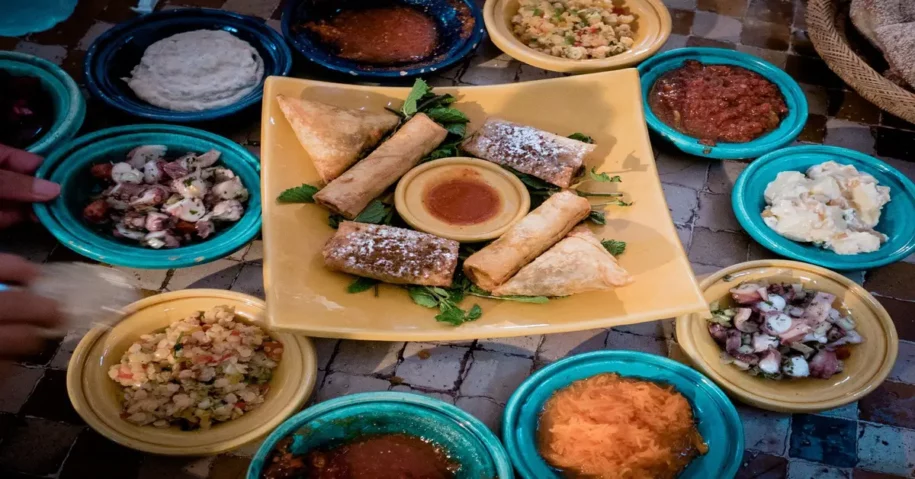What Moroccan cuisine is like
One of the easiest ways to get to know a culture is through its cuisine. Moroccan cuisine is known for its unique recipes and distinctive flavors. During my Morocco tours I had the opportunity to get to know and taste specialties from various regions. Very well seasoned, we tried a variety of dishes, from the traditional to the exotic. Shall we take a look at Moroccan cuisine?
The basis of Moroccan cuisine
Today’s Moroccan cuisine is a fusion of cuisines from other cultures such as Berber and Arabic, and is also slightly influenced by Mediterranean cuisine. Its trademark is the seasoning, which enhances the perfume, taste and colors of the dishes. The spices used are varied, such as cinnamon, cumin, ginger, saffron and paprika. Olives, lemons and oranges are also often used to make the dishes, as well as vegetables and dried fruit that are in every meal.
Vegetables are steamed. The most commonly used meats are chicken and beef, which can also be steamed or grilled on skewers. They are always very tasty, with aromas well marked by the spices.
The fruits are very sweet and colorful. Don’t miss out on orange juice, loquats and plums. Pomegranates are also widely used in cooking. Dates, which are hard to find here in Brazil, are easy to find in Moroccan markets. I’ve heard that a date tree only begins to bear fruit after 80 years. That’s why they say that those who plant dates don’t harvest dates!
Although olives are not typical of Morocco, they are always served in restaurants and accompany dishes. The green one is very good, but I didn’t like the black and red ones because they’re spicy!
A typical and exclusively Moroccan product is argan oil, which is extracted from the nuts of the Argania Spinosa plant. As well as being used in cosmetics, it is also used in Moroccan cuisine.
I must mention that the consumption of pork and alcoholic beverages is forbidden due to Muslim religious restrictions.
What meals are like in Morocco
Mint tea will be served whenever you arrive at a place as a welcome. Cold or hot, it is the most commonly served drink in the country. In the riads, it is served with almond cookies and ghoriba, a kind of coconut or almond cookie with sesame. Mouth-watering just to think about.
Breakfast includes fruit, eggs, bread with jam, pancakes and puff pastry sandwiches. I missed cheeses and cold cuts. Sometimes a polenguinho cheese appeared without being highlighted. To drink, mint tea and orange juice. Coffee, if requested, came with it. Bread is not only served at breakfast, but at every meal. The bread is so present on the table that it even serves as an auxiliary utensil to help push the food around the plate for Moroccans who don’t use cutlery.
Lunch is their main meal, except during Ramadan. A typical meal starts with salads, followed by a tagine, which is the typical Moroccan dish, eaten practically every day.
Tagines
The tagine is undoubtedly the most traditional dish, found in every restaurant and even in street stalls. It’s not actually a dish, but a way of preparing food. It’s made in a clay pot shaped like a cone. It takes a long time to cook and takes hours to get the meat tender. Once ready, the dish is served in the same pot, still bubbling hot.
Dishes prepared in tagine usually include a protein and vegetables. The most common menu item is chicken tagine with potatoes. But I’ve also eaten it with oranges, olives or plums.
Pastilla
This is my favorite Moroccan dish. I was a bit doubtful about ordering it the first time, but I ended up ordering it because the guide insisted. I simply LOVED it and ordered it every time I saw it on the menu. It’s a flaky pastry tart covered in cinnamon and sugar, usually filled with chicken and curry, with a sweet and sour spice that you can’t stop praying for. It’s so good, don’t miss it!
Kafta
Kaftas are ground meat skewers. Almost all restaurants have them on the menu. The portion of meat is usually very large (2 or 3 skewers) and comes with rice or salad.
Couscous
Couscous is a type of cereal made from wheat semolina. Steamed, it can be served with vegetables, meat or fish. It is a Berber dish (native to Morocco) and by tradition couscous is prepared on Thursday.
Stuffed pizza
One of the most popular meals in Morocco is a kind of stuffed pizza made with typical round bread dough and filled with boiled potatoes, hard-boiled egg, rice and beet.
Goat’s head
Goat meat is widely consumed in Morocco, much more than beef itself, because it’s a cheaper protein and easier to raise. As Morocco was once a very poor country that suffered from famine, they really do eat everything, all parts of the animal, including the head, eyes, tongue, ears and even the brain. These delicacies are easy to find in the stalls in Marrakech‘s Jema El-Fna square.
Snail soup
Known as escargot, snails are also present in Moroccan cuisine. They are used to make a soup prepared with typical spices and seasonings. It’s also easy to find in Marrakech’s Jeema El-Fna square. To eat, you pull the snail out of its shell with a toothpick and eat it.
Dromedary meat
This is really exotic and also very difficult to find. I only found the head for sale at a stall in the medina of Fez. The photo was taken from a distance because the shopkeeper didn’t allow me to take close-up pictures. I haven’t tried it, but they say the meat tastes like a mixture of beef and pork.

Leave a Reply